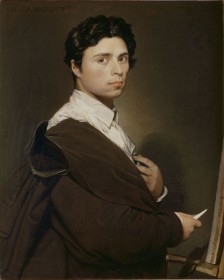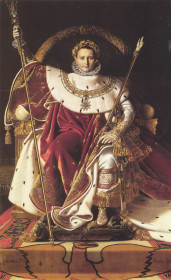 Jean Auguste Dominique Ingres. Or just Ingres as he is called today was a prolific artist of the late 18th century from born in Montauban, France; born to Jean Marie Joseph Ingres, a skillful trader of arts and Anne Moulet, a simple house wife. His father’s professional involvement in arts may have received the encouragement and the idol environment to pursue after the artistic career.
Jean Auguste Dominique Ingres. Or just Ingres as he is called today was a prolific artist of the late 18th century from born in Montauban, France; born to Jean Marie Joseph Ingres, a skillful trader of arts and Anne Moulet, a simple house wife. His father’s professional involvement in arts may have received the encouragement and the idol environment to pursue after the artistic career.
Flourishing in favorable conditions, Ingres already produced his first art-piece in 1789 at the age of nine, which was a drawing of an antique piece. Fortunately, there was no interference to his artistic progress. Though, his education did get big disturbance by the French Revolution. Actually, he had to end his conventional education in 1791, right after two years of the beginning of the revolution.
The Two Passions and Violon d’Ingres
In the same year, he was moved to Toulouse for his official study of painting in Académie Royale de Peinture, Sculpture et Architecture. There he studied his two passions of his life. First is the art for which he is famous, Painting. He took his paintings lessons mainly under the neoclassical and romantic painter Guillaume Joseph Roques. He himself was an adept painter and the main encouragement to Ingres, as he sorted out Ingres’ painting-style was reminiscent to Raphael’s. Roques education and style made a great impact on Ingres’ works.
The second passion he developed was playing a violin. Yes, many people doesn’t know that Ingres was very much interested in the art of this musical instrument and over the years spent remarkable time learning after it. There was a point when he even gave violin more importance than paintings. The Anglo-German pianist Sir Charles Halle even had to say: “He thought less of his paintings than his violin playing, which, to say the least of it, was vile”. His piano with his more than 4000 art-works is safe at the Musee Ingres (Museum of Ingres).
Even after Sir Charles Halle’s scorning there is nothing wrong in his learning of the violin. In fact, this auxiliary pursuit gave us the term “Violon d’Ingres”. It is in French and when translating in English, it means Ingres’ Violin. But the real understanding of the term is not what it sounds. The term is used to describe a person’s another activity apart from the works for what he is famous for.
Inspired by the meaningful term, American Avant-garde artist Man Ray decided to use the term as the title of his famous photograph showing the beautiful model Alice Prin.
That’s enough talk of his legacy. Now, let’s concentrate on his artistic efforts for what we are here to learn about.
The Grandeur of the Art-works
Ingres said It takes 25 years to learn to draw, one hour to learn to paint. He emphasized drawing more than painting as it is accepted to some extent in art-community. Drawing is the basic requirement for any painting.
This sentence reflects in his artistic oeuvre as it contains more than 4000 drawings! His masterful drawings require no words to describe as you can see the precision by yourself.
We have also found the drawings of his renowned paintings before the final versions. In one more line uttered by him he states: “Drawing includes three and a half quarters of the content of painting… Drawing contains everything, except the hue.”
This one and the aforementioned sentences clarifies that the artist knew the sheer importance of drawings the art of paintings, which stays behind the scenes for the general public. General public always get the representations of the final and most beautiful things to enjoy, but the effort and the originality of the substance could be derived more realistically in these drawings which he had emphasized with one more sentence: “Drawing is the probity of art. To draw does not mean simply to reproduce contours; drawing does not consist merely of line: drawing is also expression, the inner form, the plane, and modeling. See what remains after that.”
When the other artists looked drawing as a practice for their final versions, Ingres in fact, saw its own importance and not just merely a “practice” for something.
On the foundations of his fundamental knowledge about the art, he was far clearer than his contemporary artists, which helped him to produce some intelligently produced art-works which became the sacred portraits for the new artists of the time. Even today, the learners of the art glance upon his works for inspirations.
His first much talked-about work by art-community in salon, 1806 was Napoleon I on his Imperial Throne. As we can see it here, it represents the infamous French dictator Napoleon Bonaparte in lavish contemporary clothing and an impactful grace which puts memorable impression in our mind.
Well, aside from its majestic impression, the critics of the time didn’t get pleased with his work. Their claim was about the adoption of Carolingian imaginary in the portrayal, which was not suitable. And moreover, Ingres’ own stylistic idiosyncrasies were also a concern of the critics.
Extremely displeased by this severe criticism, Ingres said, “So the Salon is the scene of my disgrace; … The scoundrels, they waited until I was away to assassinate my reputation … I have never been so unhappy”, in the letter to his prospective father-in-law. Unfortunately, his vow to never come back to Paris put a sad end to the engagement with Julie Forestier. One can understand the artist’s early stage of fame in the statement done by Julie when she answered to question why she didn’t marry: “When one has had the honor of being engaged to M. Ingres, one does not marry.”
That was the start of his reputation in general public’s mind. He was emerging as a powerful artist to whom the critics will revere about, ultimately.
But as the life has certain rule, that even after anything happens it doesn’t stop anywhere, it was same for Ingres. He went Rome afterwards, working on more works and cultivating the skill to perfectness, he kept producing more works. The best of them were sent to Paris to get the reviews. But the public was indifferent even after his severe upgrades in the works. The criticism remained negative as it was from the start.
As if the criticism was not enough to discourage him, around 1815, the postwar Rome was trembling and the bad effects also caught Ingres as he lost patronage and was living on producing menial works of drawings. This was the lowest point of his career.
But, no situation stays same forever. After two years he got commission from Fernando Álvarez de Toledo, Duke of Alva.
After that, the days of glory came back too with much more strength. The Vow of Louis XIII (on right) brought him the critical success which he strived for so long. It got positively criticized in Paris and the charm of the artist suddenly returned. After that he produced more works and the most prominent art-works to note here are The Turkish Bath (1862), Oedipus and the Sphinx (1864), Portrait of Monsieur Bertin (1832), Grande Odalisque (1814), Odalisque with Slave (1842) and Roger Freeing Angelica (1819).
These are just a few names to mark which are more known than the others. You can visit Musee Ingres (Museum of Ingres) for almost all of the great art-pieces executed by him.
For paintings, he believed that “A painter can turn pennies into gold, for all subjects are capable of being transformed into poems.” And I find a timeless truth in those words.
The Last Stand
The last stand of life of this fertile artist fell upon the day of 17th January, 1867 due to pneumonia. It was a loss for humankind as it lost their one more unmatched jewel from its treasure. I have always dreamed about a technology where we will be able to revive all the great minds of the past and make them able to produce more mind-blowing works. But, that’s just one of my folly dreams.
Let’s remember him by his evocative line:
“The great masters which flourished in that century of glorious memory when Raphael set the eternal and incontestable bounds of the sublime in art … I am thus a conservator of good doctrine, and not an innovator.”


